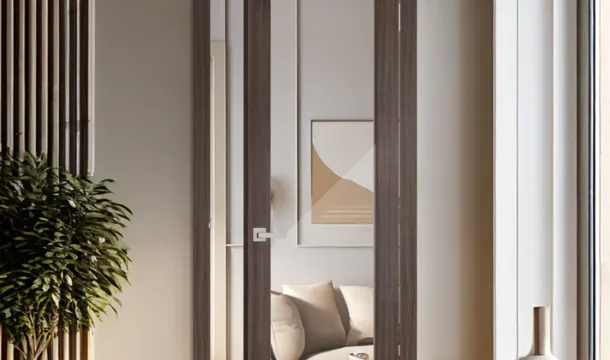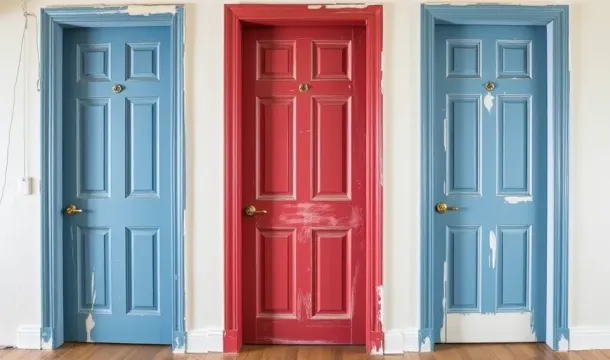Space Saving Comparison of Sliding and Swinging Interior Doors
Popular Articles
Sliding doors maximize usable space by gliding parallel to the wall, eliminating the need for clearance typically required by swinging doors. This design reduces floor area taken up by door arcs, making sliding doors ideal for compact rooms, narrow hallways, or closets where every inch counts.
Swinging doors require a clear zone equal to the door’s width plus additional buffer for comfortable operation. While they offer straightforward installation and traditional aesthetics, their space demand limits furniture placement and traffic flow in smaller interiors.
The choice between sliding and swinging interior doors hinges on balancing functionality with available space. Sliding doors excel in areas prioritizing space saving, whereas swinging doors may better suit larger rooms or where full door opening is necessary for accessibility.
Measuring Door Clearance Requirements
Accurate measurement of door clearance is critical to ensure optimal space saving and functionality for both sliding and swinging interior doors in your home. For sliding doors, allow at least 100 mm (4 inches) of wall space adjacent to the door opening for the door panel to slide fully open without obstruction. Ensure a minimum head clearance of 200 mm (8 inches) above the door frame for smooth track installation.
Swinging doors require a clear floor area equal to the width of the door plus an additional 150 mm (6 inches) on the swing side to accommodate full rotation without interference from furniture or walls. Additionally, maintain a gap of approximately 3-5 mm (0.12-0.2 inches) between the door edge and frame to prevent binding while preserving sound insulation.
The choice between sliding and swinging doors should factor in these clearance requirements relative to available space. Sliding doors maximize usable floor area by eliminating swing zones, whereas swinging doors need unobstructed arcs that can limit furniture placement. Measuring precisely before installation ensures seamless operation and maximizes space saving benefits in your home’s interior design.
Impact on Room Layout Flexibility
The choice between sliding and swinging interior doors directly affects the functionality and spatial arrangement of a home. Sliding doors enhance room layout flexibility by eliminating the arc required for door operation, freeing up adjacent wall and floor space that can be used for furniture or decor.
- Sliding Doors: These doors glide along a track parallel to the wall, allowing placement of furniture or storage units immediately next to the doorway. This setup supports versatile zoning of rooms without interruption from door clearance zones.
- Swinging Doors: Require clear space equal to the door’s width plus swing radius, often limiting where items can be positioned near entrances. This constraint reduces options for arranging seating areas, shelving, or appliances in smaller rooms.
For homes with compact or multifunctional spaces, sliding doors offer greater adaptability in configuring layouts that optimize available space without compromising passageways. Conversely, swinging doors may suit larger rooms where open floor plans already accommodate their clearance needs.
- Assess intended furniture placement before selecting door type to ensure unimpeded flow and maximize usable area.
- Consider sliding doors when flexible partitioning is desired, such as creating temporary separations in open-concept interiors.
- If privacy and complete closure are priorities alongside layout concerns, verify that sliding hardware meets sealing performance comparable to swinging models.
The comparison underscores that sliding interior doors generally provide superior room layout flexibility by preserving valuable space otherwise reserved for door swing zones. This advantage directly enhances overall home functionality while supporting diverse design choices.
Storage Solutions Behind Doors
Maximize home space by utilizing the area behind interior doors for storage, an often overlooked opportunity in the choice between sliding and swinging doors. Sliding doors provide a flat surface against the wall when open, allowing installation of slim shelves or hooks directly behind them without impeding functionality. This preserves room space while adding practical storage for items like cleaning supplies, shoes, or seasonal accessories.
Swinging doors require clearance to open fully, which limits usable storage immediately behind the door’s swing path. However, narrow vertical racks or magnetic organizers mounted on the inside face of swinging doors can enhance storage without compromising door operation or room layout. This solution suits smaller items and keeps essentials within easy reach.
Comparing both options, sliding doors support larger and more varied storage installations behind them due to their parallel movement alongside walls. Choosing sliding doors contributes not only to space saving but also to expanded storage capacity in compact interiors. For homes prioritizing multifunctional use of every square foot, integrating tailored shelving systems behind sliding doors optimizes both accessibility and overall room organization.
Installation Constraints for Small Spaces
Sliding doors require precise wall clearance along the track length, typically 70-100% of the door width, which can limit placement options in tight interiors. Ensure the adjacent wall is free from obstructions like light switches or moldings to allow smooth operation. Track installation demands a solid and level surface; uneven walls or ceilings increase complexity and may necessitate additional framing.
Swinging doors need clear floor space equal to their full arc of motion, usually 30-40 inches beyond the door frame. In compact rooms, this often restricts furniture arrangement and traffic flow. Installing swinging doors near corners or narrow hallways requires careful measurement to avoid collisions with walls or fixtures.
For homes with limited square footage, choosing sliding doors helps save usable space but involves ensuring enough wall area for the door panel to slide fully open without obstruction. Conversely, swinging doors offer simpler installation but demand unrestricted clearance for safe operation.
The comparison of these interior door types must factor in structural elements such as stud placement and header support, especially when modifying existing walls in small spaces. Reinforcement might be necessary for heavier sliding systems or wide swinging doors to maintain stability.
Space-saving choice hinges on balancing operational clearance with architectural constraints; evaluating these parameters before purchase streamlines installation and optimizes room functionality.
Maintenance Impact on Space Usage
Sliding doors require regular track cleaning and occasional roller adjustments to maintain smooth operation, but these tasks do not demand additional space around the door. Proper maintenance keeps sliding doors functioning within their minimal footprint, preserving valuable room area. Neglecting track upkeep may cause jamming, which can lead to temporary obstruction of adjacent wall sections used for furniture or decor.
Swinging interior doors need clear clearance zones for hinge lubrication and frame inspection. Maintenance activities often require temporarily moving nearby furniture or removing doorstops, which can intrude into the room’s functional space during servicing. Over time, sagging hinges or misalignment necessitate repairs that might involve trimming the door edge or adjusting the frame–procedures that can reduce effective doorway width if not carefully managed.
From a functionality standpoint, sliding door maintenance is less disruptive to home space usage since it rarely extends beyond the existing installation area. Swinging doors demand more maneuvering room during upkeep, impacting how homeowners arrange surrounding furnishings and limiting use of adjacent spaces until service is complete.
Choosing sliding doors supports consistent space efficiency by minimizing maintenance-related spatial intrusions, while swinging doors require planning for temporary clearance zones during servicing to avoid compromising room layout.
Popular Articles

Choosing the Perfect Interior Doors for Your Canadian Home

A Complete Guide to Choosing Interior Doors for Canadian Homes
